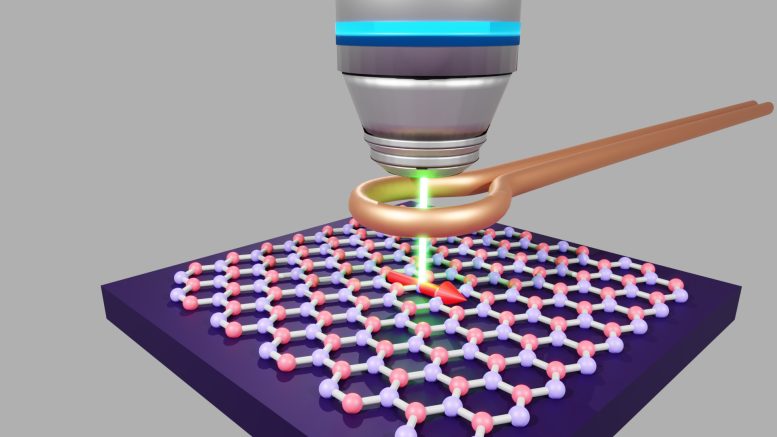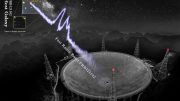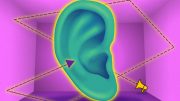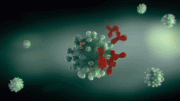
Researchers at the Cavendish Laboratory have identified spin coherence in atomic defects within Hexagonal Boron Nitride (hBN) under ambient conditions, a rare achievement in quantum materials. The study, published in Nature Materials, highlights that these spins can be controlled with light and have promising implications for future quantum technologies, including sensing and secure communications. The findings also stress the need for further exploration to enhance defect reliability and extend spin storage times, underlining the potential of hBN in advancing quantum technological applications. Credit: Eleanor Nichols, Cavendish Laboratory
Scientists at the Cavendish Laboratory have discovered spin coherence in Hexagonal Boron Nitride (hBN) under normal conditions, offering new prospects for quantum technology applications.
Cavendish Laboratory researchers have discovered that a single ‘atomic defect’ in a material known as Hexagonal Boron Nitride (hBN) maintains spin coherence at room temperature and can be manipulated using light.
Spin coherence refers to an electronic spin being capable of retaining quantum information over time. The discovery is significant because materials that can host quantum properties under ambient conditions are quite rare.
The findings published in Nature Materials, further confirm that the accessible spin coherence at room temperature is longer than the researchers initially imagined it could be. “The results show that once we write a certain quantum state onto the spin of these electrons, this information is stored for ~1 millionth of a second, making this system a very promising platform for quantum applications,” said Carmem M. Gilardoni, co-author of the paper and Rubicon postdoctoral fellow at the Cavendish Laboratory.
“This may seem short, but the interesting thing is that this system does not require special conditions – it can store the spin quantum state even at room temperature and with no requirement for large magnets.”
Characteristics of Hexagonal Boron Nitride
Hexagonal Boron Nitride (hBN) is an ultra-thin material made up of stacked one-atom-thick layers, kind of like sheets of paper. These layers are held together by forces between molecules. But sometimes, there are ‘atomic defects’ within these layers, similar to a crystal with molecules trapped inside it. These defects can absorb and emit light in the visible range with well-defined optical transitions, and they can act as local traps for electrons. Because of these ‘atomic defects’ within hBN, scientists can now study how these trapped electrons behave. They can study the spin property, which allows electrons to interact with magnetic fields. What’s truly exciting is that researchers can control and manipulate the electron spins using light within these defects at room temperature.
This finding paves the way for future technological applications, particularly in sensing technology.
However, since this is the first time anyone has reported the spin coherence of the system, there is a lot to investigate before it is mature enough for technological applications. The scientists are still figuring out how to make these defects even better and more reliable. They are currently probing how far we can extend the spin storage time, and whether we can optimize the system and material parameters that are important for quantum-technological applications, such as defect stability over time and the quality of the light emitted by this defect.
Future Prospects and Concluding Remarks
“Working with this system has highlighted to us the power of the fundamental investigation of materials. As for the hBN system, as a field we can harness excited state dynamics in other new material platforms for use in future quantum technologies,” said Dr. Hannah Stern, first author of the paper, who conducted this research at the Cavendish Laboratory and is now a Royal Society University Research Fellow and Lecturer at the University of Manchester.
In the future, the researchers are looking at developing the system further, exploring many different directions from quantum sensors to secure communications.
“Each new promising system will broaden the toolkit of available materials, and every new step in this direction will advance the scalable implementation of quantum technologies. These results substantiate the promise of layered materials towards these goals,” concluded Professor Mete Atatüre, Head of the Cavendish Laboratory, who led the project.
Reference: “A quantum coherent spin in hexagonal boron nitride at ambient conditions” by Hannah L. Stern, Carmem M. Gilardoni, Qiushi Gu, Simone Eizagirre Barker, Oliver F. J. Powell, Xiaoxi Deng, Stephanie A. Fraser, Louis Follet, Chi Li, Andrew J. Ramsay, Hark Hoe Tan, Igor Aharonovich and Mete Atatüre, 20 May 2024, Nature Materials.
DOI: 10.1038/s41563-024-01887-z








Be the first to comment on "Cambridge Scientists Achieve Long-Sought Quantum State Stability in New 2D Material"